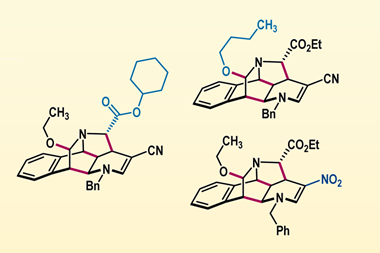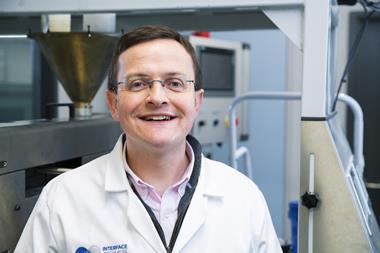Researchers have engineered a polymer that folds up like a protein when exposed to UV light
Researchers in the Netherlands have created a polymer that folds up like a protein on exposure to light.1 Non-covalent interactions are responsible for the collapse of the polymer, but while hydrophobic interactions drive protein folding, hydrogen bonding folds the polymer.
’Natural polymers, like proteins, are functional due to their highly ordered well-defined three-dimensional structures,’ says Tristan Mes of the Eindhoven University of Technology. Mes’ synthetic polymer is packed with benzene-1,3,5-tricarboxamide (BTA) side chains that are connected by hydrogen bonds. Normally, these pull the polymer in on itself around a chiral centre of stacked BTA.

By photoprotecting the BTA with nitrobenzyl groups, the team added a trigger so that the folded polymer could only be obtained by external stimuli. Shining UV light on the polymer cleaves the protecting groups, causing it to fold up.
’By making use of photo-deprotection in combination with heating/cooling steps we can really control the folding,’ says Mes. ’We have observed that the folding of these systems partly mimics protein folding.’
But Andrew Wilson of the University of Leeds, UK, says he is not so sure. ’I think what’s really cool is that you get different degrees of H-bond mediated collapse depending on irradiation time and temperature - this hasn’t really been demonstrated before and is of course a function of biological macromolecules.’ But Wilson is unsure that folding is the right word for what the polymers do, explaining that pulling apart the polymer and allowing it to collapse will lead to a different superstructure each time, unlike proteins.
Mes and colleagues have also harnessed hydrophobic interactions in water to fold a BTA polymer intramolecularly.2 This folding bears a closer resemblance to that of the proteins which they are trying to mimic. In this case, these BTA polymers are wrapped around a catalytic ruthenium core to make a polymerisation ’enzyme’. Mes says the group now hopes to make artificial enzymes for asymmetric catalysis by using a chiral core of stacked BTA moieties.
Laura Howes
References
at alAngew. Chem. Int. Ed.et al133, 4742.






No comments yet